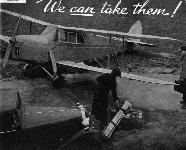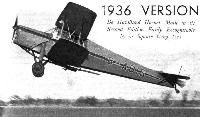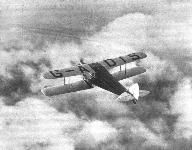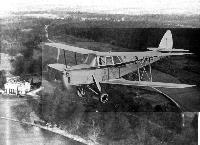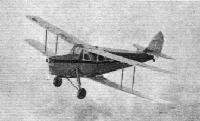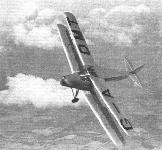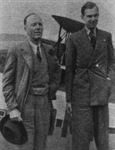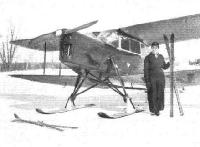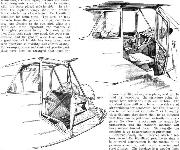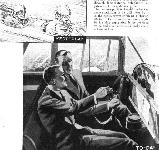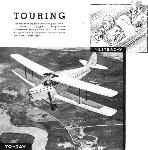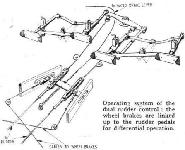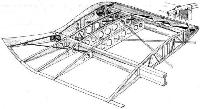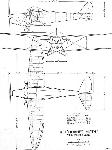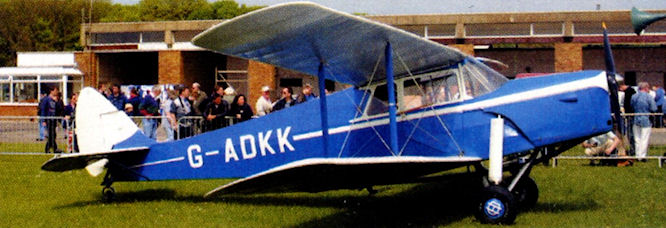
de Havilland DH.87 Hornet Moth
Для поклонников комфортабельных бипланов фирма разработала самолет DH.87 Hornet Moth, близкий по конструкции к DH.86, у которого оба члена экипажа сидели бок о бок в закрытой кабине. Это был одностоечный биплан с матерчатой обшивкой деревянного крыла, имевшего небольшое сужение к законцовкам, с фюзеляжем квадратного сечения из сосны и фанеры и с шасси с хвостовым костылем и независимыми основными стойками. Первый прототип взлетел в Хэтфилде 9 мая 1934 года, а во время продолжавшихся более года испытаний к нему присоединились еще два аналогичных самолета. Поставки серийных машин, получивших обозначение DH.87A Leopard Moth, начались в августе 1935 года. Было выпущено более 60 самолетов этой модификации, имевших новое крыло с увеличенными размахом и сужением. Но в 1936 году был введен тип крыла, впервые опробованный на втором серийном Hornet Moth. Новые несущие поверхности не имели сужения, а их законцовки были практически прямоугольной формы, и их можно было установить на уже выпущенные машины по желанию владельца. Этим крылом оснастили также 100 новых самолетов, получивших обозначение DH.87B Leopard Moth. После того, как фирма "de Havilland Aircraft of Canada" разработала вариант с поплавковым шасси, в 1937 году Министерство авиации приобрело четыре такие машины для испытаний в качестве учебных самолетов. В общей сложности построили 165 Hornet Moth, включая прототип.
ТАКТИКО-ТЕХНИЧЕСКИЕ ХАРАКТЕРИСТИКИ
de Havilland DH.87B Hornet Moth (с колесным шасси)
Тип: двухместный туристический самолет
Силовая установка: один рядный поршневой двигатель de Havilland Gipsy Major мощностью 130 л. с. (97 кВт)
Летные характеристики: максимальная скорость на оптимальной высоте 200 км/ч; крейсерская скорость на оптимальной высоте 169 км/ч; начальная скороподъемность 210 м/мин; потолок 4510 м; дальность полета 998 км
Масса: пустого 563 кг; максимальная взлетная 885 кг
Размеры: размах крыльев 9,73 м; длина 7,61 м; высота 2,01 м; площадь крыльев 20,44 м2
Описание:
- de Havilland DH.87 Hornet Moth
- Flight, July 1934
NEW AEROPLANES IN KING'S CUP RACE - Flight, June 1935
THE “HORNET MOTH" - Flight, March 1936
"SQUARE-TIPPED" - Flight, April 1936
MODERN LIGHT AIRCRAFT REVIEWED
Фотографии
-
Aeroplane Monthly 1978-09 / de Havilland D.H.87 Hornet Moth /Preservation Profile/ (65)
Регистрационный номер: G-ADLY [8] -
Мировая Авиация 214
Регистрационный номер: CF-BFG Компания «De Havilland of Canada Ltd» импортировала и собрала 11 Hornet Moth, на самолетах применялось металлическое поплавковое шасси марки «Fairchild». Авиационное министерство получило в опытную эксплуатацию четыре машины.
-
Мировая Авиация 139
Регистрационный номер: G-ADKK [2] Начав с DH.60 Moth, Джеффри де Хэвилленд спроектировал серию своих знаменитых легких самолетов межвоенного периода - Moth. Биплан DH.87 Hornet Moth обладает характерным для всех Moth хвостовым оперением, "Moth tail".
-
Мировая Авиация 105
Регистрационный номер: G-ADLY [8] Среди старых самолетов de Havilland до наших дней сохранился один DH.87B Hornet Moth с регистрационным номером G-ADLY.
-
Aviation Historian 40 / P.Marson - Southern charm
Регистрационный номер: G-ADLY [8] Acquired by Bellamy for the Hampshire Aeroplane Club in April 1959, G-AHKB (c/n 6596) retained the blue and white colour scheme applied by its previous owner, Vickers-Armstrongs, although the club’s titles were applied to the forward fuselage beneath the cockpit. The aircraft is seen here at Eastleigh with one of the club’s D.H.87 Hornet Moths, G-ADLY, in the background.
Другие самолёты на фотографии: De Havilland Dragon Rapide / Dominie / D.H.89 - Великобритания - 1934
-
Мировая Авиация 214
Регистрационный номер: G-ADMT [5] G-ADMT Curlew оказался в числе десятка Hornet Moth, сохранившихся до настоящего времени.
-
Aeroplane Monthly 1994-12 / de Havilland D.H.87B Hornet Moth G-ADND/"W9385" /Preservation Profile/
Регистрационный номер: W9385 The repainted Hornet Moth being flown by Bill Bowker on June 5, 1994.
-
Aeroplane Monthly 1997-12 / M.Oakey - Vintage news
Регистрационный номер: G-ADKC Hornet Moth G-ADKC running-up with its new prop.
-
Flight 1934-07 / Flight
Another Selection of King's Cup Machines (1) D.H. "Hornet Moth," D.H. "Gipsy Major" 130 h.p. engine.
-
Flight 1935-06 / Flight
Регистрационный номер: G-ADIS [13] A NEW DE HAVILLAND MACHINE: The "Hornet Moth" (130 h.p. "Gipsy Major") is a side-by-side two-seater. It will be seen for the first time at the S.B.A.C. Display.
-
Flight 1935-07 / Flight
Регистрационный номер: G-ADIS [13] Although a biplane and a cabin machine, the "Hornet Moth," as this view shows, is clean aerodynamically. The undercarriage compression leg is an oleo type by Dowty, and the sloping windscreen is a curved one-piece one of cellon.
-
Flight 1935-12 / Flight
Регистрационный номер: G-ADIS [13] Speed and comfort. The D.H. Hornet Moth, which has very comfortable seating for two side by side.
-
Flight 1936-02 / Flight
Регистрационный номер: G-ADIS [13], G-ADKR THE OLD ORDER CHANGETH: This photograph affords an interesting comparison between the 1935 and 1936 versions of the de Havilland Hornet Moth.
-
Flight 1935-07 / Flight
Регистрационный номер: G-ADIS [13] -
Flight 1936-01 / Flight
Регистрационный номер: G-ADIS [13] OUTSTANDING CIVIL TYPE: The De Havilland Hornet Moth (130 h.p Gipsy Major) side-by-side two-seater.
-
Flight 1935-07 / Flight
The new "Hornet Moth" in the clouds - those which heralded last week's thunderstorm - at 10,000 feet.
-
Flight 1935-07 / Flight
Регистрационный номер: G-ADIS [13] The D.H. Hall Mark: A fine view which shows the heavily tapered wings of the "Hornet Moth," a distinctive feature of all modern De Havilland aeroplanes.
-
Aeroplane Monthly 1977-12 / N.Parnell - Tinea Rarus
Регистрационный номер: VH-UTE [2] -
Aeroplane Monthly 1977-12 / N.Parnell - Tinea Rarus
Регистрационный номер: VH-UTE [2] The sole surviving airworthy example of the D.H.87A, VH-UTE, displays its tapered wings. Owners of D.H.87As were later invited to trade in their wings for the square-cut units of the D.H.87B
-
Aeroplane Monthly 1978-09 / de Havilland D.H.87 Hornet Moth /Preservation Profile/ (65)
Регистрационный номер: G-ADLY [8] As D.H.87A Leicestershire Foxhound II, late in 1935.
-
Aeroplane Monthly 1978-09 / de Havilland D.H.87 Hornet Moth /Preservation Profile/ (65)
Регистрационный номер: G-ADLY [8] A SPECIAL HORNET: Mr. W. Lindsay Everard's new D.H. Hornet is fitted with a Reid and Sigrist Gyorizon, a drift sight and an extra locker. The colour scheme, as in the case of his previous machines, is blue and red with red leather upholstery.
-
Air Pictorial 1957-10 / Air Pictorial's photo-review
Регистрационный номер: CF-AYG Of three D.H. Hornet Moths in Canada this is the only pointed-wing D.H.87A (c/n, 8031; CF-AYG).
-
Flight 1936-12 / Flight
Регистрационный номер: G-ADIS [13] -
Flight 1936-02 / Flight Advertisements
Регистрационный номер: G-ADIS [13] -
Flight 1936-04 / Flight
Регистрационный номер: G-ADIS [13] In its new form the Hornet Moth has a remarkably short take-off and climbs steeply as soon as it is clear of the ground. As may be gathered, both pilot and passenger have an excellent view in the forward hemisphere as well as through the roof light.
-
Flight 1936-02 / Flight
Регистрационный номер: G-ADIS [13] Comfort and good view in all essential directions are features of the 1936 Hornet Moth, which, with side-by-side seating is equally suitable for touring and tuition. With a 130 h.p. Gipsy Major engine, the maximum speed is about 124 m.p.h. and the cruising speed 103-108 m.p.h., according to the degree of throttling.
-
Flight 1936-03 / Flight
Регистрационный номер: G-ADIS [13] This somewhat unusual flying picture of the Hornet Moth gives a good idea of the upward and rearward view given by the roof windows and also clearly shows the new wing form.
-
Flight 1936-02 / Flight
Регистрационный номер: G-ADIS [13] The D.H. "Hornet Moth" Two-seat Light Cabin biplane (130 h.p. D.H. "Gipsy-Major" engine).
The attractive aerial view was "posed" for Flight's photographer by Mr. H. Buckingham of the De Havilland Company. -
Air-Britain Archive 1980-02
Регистрационный номер: G-ADMT [5] The well-known D.H.87 Hornet Moth which is now in production again, provides exceptionally comfortable transport for two people and their luggage.
A pre-war study of Hornet Moth G-ADMT -
Flight 1936-06 / Flight
D.H. Hornet (Gipsy Major)
-
Flight 1936-11 / Flight
Регистрационный номер: G-ADMT [5] Popular De Havilland biplane: the Hornet Moth (Gipsy Major), a side-by-side two-seater for private or club
-
Air-Britain Archive 1982-02
Регистрационный номер: G-ADKK [2] G-ADKK became W5749 and was restored on 12.6.46. It moved to Wyberton in 1974 with C.W.Annis and adopted the familiar blue and white colours of other vintage Boston residents, as demonstrated at Air-Britain's Fly-In at Old Warden on 22.7.79.
-
Aeroplane Monthly 1991-10 / Personal album. Civil
Регистрационный номер: G-ADKM [2], G-AFMP A pair of D.H.87 Hornet Moths of the Exeter Aero Club, at Exeter in August 1939. G-ADKM was registered in November 1935. In January 1940 it was impressed into RAF service as W5751; it was restored to the register in May 1946 and is still extant. G-AFMP was impressed as W5782 at the same time but on February 29, 1940 it stalled and crashed while landing at RAF St Eval and was struck off RAF charge.
-
Air-Britain Archive 1982-02
Регистрационный номер: G-ADKM [2] G-ADKM was also restored on 20.5.46 after being W5751. It was bought by current owner F.Hayter in 1964 and appeared at many sporting events as seen here at Swansea on 14.8.71 for the Welsh Aerial Derby/King's Cup meeting.
-
Aeroplane Monthly 1978-09 / de Havilland D.H.87 Hornet Moth /Preservation Profile/ (65)
Регистрационный номер: G-ADLY [8] Flying from Shoreham on June 26 last year.
-
Aeroplane Monthly 1978-09 / de Havilland D.H.87 Hornet Moth /Preservation Profile/ (65)
Регистрационный номер: G-ADLY [8] At Elstree in the early 1970s, now a D.H.87B.
-
Air-Britain Archive 1982-02
Регистрационный номер: G-ADLY [8] G-ADLY served as W9388 before being restored on 20.5.46. It is shown here at home at Eastleigh on 28.3.61 while in Viv Bellamy's ownership.
-
Aeroplane Monthly 1988-10 / Personal album. Civil
Регистрационный номер: G-ADMO D.H.87 Hornet Moth G-ADMO, registered in May 1935, seen at Heston in 1936. During the war it flew as AV969, and afterwards it was civilianised for de Havilland’s Danish representative - but he never took delivery. It is believed that the aircraft was finally sold in Leopoldville.
-
Flight 1936-12 / Flight Advertisements
Регистрационный номер: G-ADMT [5] -
Flight 1936-12 / Flight
Регистрационный номер: G-ADMT [5] SOCIABILITY AND SAFETY: This unusual flying picture of the D.H. Hornet Moth reflects credit on the pilots both of the D.H. 87B (the official designation of the Hornet) and of the machine which carried Flight's photographer. Incidentally, its price has just been reduced to ?775 - a figure which is distinctly reasonable for a side-by-side cabin machine of this type. With a normal range of 600 miles and possessing excellent "small field" capabilities on full load, the Hornet, though not exceptionally fast (it cruises at 105 m.p.h. or a little less), is a really useful private owner's aeroplane. Its eood take-off gives it possibilities as a floatplane and at least one machine has been successfully flying in this guise over in Canada.
-
Aeroplane Monthly 1983-02 / L.Curtis - Flying for all
Регистрационный номер: G-ADNB [2] The D.H.87 Hornet Moth was a popular Civil Air Guard type.
-
Aeroplane Monthly 1990-09 / D.Sparkes - Lost weekend (2)
Регистрационный номер: G-ADNB [2] Hartas low and fast in Hornet Moth G-ADNB. He was to take 11th place in the King 's Cup, recording an average speed of 117-5 m.p.h. for the course.
-
Aeroplane Monthly 1994-12 / de Havilland D.H.87B Hornet Moth G-ADND/"W9385" /Preservation Profile/
Регистрационный номер: G-ADND [4] G-ADND pre-war, during Fairey ownership.
-
Aeroplane Monthly 1994-12 / de Havilland D.H.87B Hornet Moth G-ADND/"W9385" /Preservation Profile/
Регистрационный номер: G-ADND [4] G-ADND at Hatfield on the occasion of the abandoned 1951 King’s Cup air race on June 23.
-
Aeroplane Monthly 1994-12 / de Havilland D.H.87B Hornet Moth G-ADND/"W9385" /Preservation Profile/
Регистрационный номер: G-ADND [4] G-ADND in the Seventies.
-
Air-Britain Archive 1982-02
Регистрационный номер: G-ADND [4] After spending most of the war as W9385 at St.Athan G-ADND flew for many years with P.Q.Reiss until joining the Shuttleworth collection in 1971. It was caught at Biggin Hill a few months earlier on 14.3.71 by J.W.Ware.
-
Aeroplane Monthly 1989-02 / Personal album. Civil
Регистрационный номер: G-ADNE [2] Registered in April 1936, Hornet Moth G-ADNE is pictured at Desford shortly after it emerged from Hatfield. Later it was impressed into RAF service as X9325. The Hornet survived the war, was restored to the register in July 1946 and is still airworthy today.
-
Aeroplane Monthly 1974-09 / News Spotlight
Регистрационный номер: G-ADNE [2] Visiting de Havilland types on both sides of the fence.
-
Aeroplane Monthly 1988-06 / M.Oakey - Grapevine
Регистрационный номер: G-ADOT [4] Silver and green D.H. Hornet Moth G-ADOT was rolled out at Salisbury Hall on April 10, 1988 as the Mosquito Aircraft Museum's latest restoration.
-
Aeroplane Monthly 1994-03 / B.Elliott - Above, the law (2)
Регистрационный номер: G-ADOT [4] D.H. Hornet Moth G-ADOT was used by the Buckinghamshire Constabulary during 1956. Today ’OT is statically exhibited at the Mosquito Aircraft Museum at Salisbury Hall.
-
Aeroplane Monthly 1986-01 / 1986 UK Aircraft Collections and Museums Guide
Регистрационный номер: G-ADOT [4] Hornet Moth G-ADOT.
-
Aeroplane Monthly 1981-08 / Broxbourne /Gone but not forgotten/ (11)
Регистрационный номер: G-ADOT [4] Line up of Herts & Essex types at Broxbourne in 1947; Tiger Moths, Proctors and a Hornet Moth,
Другие самолёты на фотографии: De Havilland Tiger Moth / D.H.82 - Великобритания - 1931Percival Proctor / P.28 - Великобритания - 1939
-
Aeroplane Monthly 1988-01 / Personal album. Civil
Регистрационный номер: G-ADUR This de luxe de Havilland D.H.87 Hornet Moth, complete with wheel spats, was first registered in March 1936. Note the 600 (City of London) RAuxAF Sqn crest on the fin. G-ADUR somehow escaped RAF impressment and has an almost unbroken post-war flying career. Today it is in the safe hands of de Havilland aircraft collector Brian Woodford.
-
Air-Britain Archive 1983-02
Регистрационный номер: G-AELO Intended for the Royal Navy in April 1940 but in fact taken on charge by the RAF as AW118, Hornet Moth G-AELO was restored on 20.8.47 and is still active as seen in this take-off study at the PFA Rally at Leicester in July 1980.
-
Aeroplane Monthly 1991-01 / Personal album. Civil
Регистрационный номер: G-AESE [3] First registered in January 1937 Hornet Moth G-AESE is still airworthy, and is owned and flown by Capt Geoff Green. This photograph was taken at Biel, Switzerland, on July 3, 1960 during the annual Swiss Watch Fly-in.
-
Aeroplane Monthly 1990-04 / ??? - Ah! Woburn
Регистрационный номер: G-AESE [3] Geoff Green's immaculate D.H.87B Hornet Moth was this year’s Moth Club concours d’elegance winner.
-
Aeroplane Monthly 1979-08 / ??? - The Famous Grouse DH Moth Air Rally
Регистрационный номер: G-AESE [3] A composite panoramic view of Hatfield on Friday evening, June 29, 1979.
Другие самолёты на фотографии: De Havilland Puss Moth / D.H.80 - Великобритания - 1929De Havilland Tiger Moth / D.H.82 - Великобритания - 1931
-
Air-Britain Archive 1984-01
Регистрационный номер: G-AEWY Hornet Moth G-AEWY of Norman Jones at Rhoose 4.6.60 did not survive an accident at Barton in April 1964
-
Air Pictorial 1957-10
Регистрационный номер: G-AMZO The adjacent Changes of Ownership include the Hornet Moth, G-AMZO. This is one of the most interesting current light planes, having belonged to the Malayan Aero Club as VR-RAI in 1936, sold in Denmark where it remained as OY-DEZ until 1942, and finally sold in Sweden as SE-ALD until registered in the U.K. in the summer of 1952.
-
Aeroplane Monthly 1998-12 / M.Hooks - Weekend jolly /Inter-war civil/
Регистрационный номер: EC-BBF, OE-DKS Part of the visiting aircraft park at Heston. Visible are Hornet Moths EC-BBF and OE-DKS, BA Eagle HB-DES, Klemm KI 32 D-EREQ, Heinkel Kadett D-EQOS, Leopard Moths HB-ARI and HB-EFE, and Waco UIC PH-MAG.
Другие самолёты на фотографии: British Klemm BK-1 Eagle - Великобритания - 1934De Havilland Leopard Moth / D.H.85 - Великобритания - 1933Heinkel He-72 Kadett - Германия - 1933Klemm Kl.32 / Kl.36 - Германия - 1932WACO C / S Series - США - 1931
-
Aeroplane Monthly 1979-04 / ??? - The Famous Grouse DH Moth Air Rally
Регистрационный номер: OY-DEZ [2] OY-DEZ over Stauning, Denmark, in June 1975. Photographed by TORKILD BALSLEV.
-
Aeroplane Monthly 1979-08 / ??? - The Famous Grouse DH Moth Air Rally
Регистрационный номер: OY-DEZ [2] The Danish Hornet Moth OY-DEZ en route to Strathallan.
-
Aeroplane Monthly 1981-11 / H.Best-Devereux, I.Best-Devereux - Oshkosh '81
Регистрационный номер: VH-UVV This D.H.87B Hornet Moth arrived at Oshkosh via a Qantas Boeing 747.
-
Aeroplane Monthly 1979-04 / Personal album
Yet another visitor was de Havilland D.H.87B Hornet Moth 1522 of the SAAF, from the batch 1401-1600 allocated to 200 impressed civil aircraft. It was one of 17 imported Hornet Moths assembled by the de Havilland Aircraft Co of South Africa and registered as ZS-AHF on April 29, 1936. Impressed in 1940, it reverted to its civil identity post-war and was scrapped in 1950.
-
Aeroplane Monthly 1982-06 / ??? - Strangers on deck
Two photographs of an anonymous impressed D.H.87 Hornet Moth aboard an unidentified carrier, presumably during the war.
-
Flight 1935-07 / Flight
The amount of windscreen visible in this head-on view of the "Hornet Moth" shows the success of the designer's efforts to provide the pilot with a good outlook.
-
Flight 1936-08 / Flight
INSTRUCTIONAL FLEET: Now that the London Aeroplane Club have obtained their new D.H. Dragonfly for twin-engined training their instructional fleet is one of the most complete in the country. In this Flight photograph there will be seen the Dragonfly, two Hornet Moths and five of the six Tiger Moths. In the foreground (though not to be recognised) are Messrs. Rodwell, Harris, Goodyear and Maclaren, respectively secretary, chief instructor and assistant instructors.
Другие самолёты на фотографии: De Havilland Dragonfly / D.H.90 - Великобритания - 1935De Havilland Tiger Moth / D.H.82 - Великобритания - 1931
-
Air-Britain Archive 1982-03
To celebrate the centenary of the birth of Geoffrey de Havilland, the Moth Club arranged an aerial weekend tour for vintage DH types to such locations as Hatfield, Chester and Farnborough. It ended at White Waltham on 4.7.82 with the scene shown, forty-eight DH aircraft and various support craft all on the field together.
For the record, those visible were as follows: (all Tiger Moths unless stated) nearest row left to right: G-AOZB, G-APFU, G-ANTE, G-APMX, G-ANCS, G-AAWO DH.60G, G-AGYU, G-BEWN, G-EBLV DH.60, G-AOEG; second row G-AAZP DH.80A, G-AZCB SV.4C, N82AM, G-ASPV, G-AOAA, G-AEOA DH.80A, D-EEAJ, G-AYIT, G-ANFM and wingtips of G-ALIW; third row G-ANOH, G-AHBL DH.87B, G-ADGV, G-ANRN, G-ADND DH.87B, G-ANJA, G-ANDP, F-BGCS, G-ARAZ, G-AJOA, G-ANZU, G-ALWW; back row G-AELO DH.87B, G-AOEI, G-ACMN DH.85, G-AOZH, G-AIXD, G-AKIF DH.89A, T8191, G-AAMY DH.60G, G-ABEV DH.60G, HB-UBC, G-BFHH, PH-CSL and Proctor 4 G-ANXR. Present, but not visible in this shot were Tiger Moths G-ANFW, G-BACK; Jackaroo G-AOIR; DH.85 G-AIYS; DH.90 G-AEDU and various supporters including Great Lakes D-EBGL and Proctor G-AOGE.
Anyone requesting the registrations of the three Cherokees and the Sipa will have their subscriptions cancelled immediately!Другие самолёты на фотографии: De Havilland Dragon Rapide / Dominie / D.H.89 - Великобритания - 1934De Havilland Gipsy Moth / Moth X - Великобритания - 1928De Havilland Leopard Moth / D.H.85 - Великобритания - 1933De Havilland Puss Moth / D.H.80 - Великобритания - 1929De Havilland Tiger Moth / D.H.82 - Великобритания - 1931Percival Proctor / P.28 - Великобритания - 1939Stampe et Vertongen SV-4 - Бельгия - 1933
-
Flight 1938-10 / Flight
AN AFRICAN RALLY: More than seventy machines appeared at the Lourenco Marques aerodrome for the air rally early last month.In this aerial photograph most of them are seen parked in front of the D.E.T.A. hangar. On the tarmac are this concern's three recently acquired Ju.52s, while on the right there are the four Rapides, the Dragonfly and the Hornet which are also used by the company.
Другие самолёты на фотографии: De Havilland Dragon Rapide / Dominie / D.H.89 - Великобритания - 1934De Havilland Dragonfly / D.H.90 - Великобритания - 1935Junkers Ju.52/3m - Германия - 1931
-
Flight 1936-12 / Flight
Другие самолёты на фотографии: Armstrong Whitworth Atlas / Ajax - Великобритания - 1925Armstrong Whitworth Siskin - Великобритания - 1921Avro Avian / Type 594/616 - Великобритания - 1926Avro Cadet / Type 631/643 - Великобритания - 1932Avro Five / Type 619 / Six / Type 624 - Великобритания - 1929Avro Tutor/Sea Tutor/Prefect / Type 621/646/626 - Великобритания - 1929De Havilland Leopard Moth / D.H.85 - Великобритания - 1933Saunders-Roe Cutty Sark / A.17 - Великобритания - 1929
-
Jane's All the World Aircraft 1938 / 01 - The progress of the world in civil aviation during the year 1937-38
URBANITY AT DURBAN. - A Goup of Pupils and Personnel of Natal Aviation (Pty.) Ltd. on their home airport of Durban. The company's fleet, in the background, contains a D.H. "Dragon," "Leopard-Moth," "Hornet-Moth," "Tiger-Moth" and five "Gipsy-Moth".
Другие самолёты на фотографии: De Havilland Dragon / D.H.84 - Великобритания - 1932
-
Flight 1939-06 / Flight
Lord Londonderry, who flew his Hornet Moth into seventh place in the London-Isle of Man race, with his navigator, Flt. Lt. H. T. Ferrand of No. 502 (Ulster) (G.R.) Squadron.
-
Flight 1937-10 / Flight
Mr. Douglas Fawcett with his Hornet Moth. An experienced mountaineer, he spends much of his time in Switzerland, flying blissfully in all sorts of weather, over, around and among the peaks which he knows so well. He is the brother of Colonel Fawcett, who disappeared while exploring the Amazon.
-
Flight 1936-09 / Flight
Fig. 2: The Hornet Moth wing at 46 and 70 m.p.h. (superimposed).
-
Flight 1936-04 / Flight
THE GIRL OF THE LIMBERLOST: The first photograph of a D.H. Hornet Moth on skis. It was taken at Limberlost, a popular winter sports resort north of Toronto, and with the machine is Mrs. Lee Murray, wife of Mr. Lee Murray, who manages the Canadian De Havilland Company.
-
Flight 1937-03 / Flight
Регистрационный номер: CF-AYI The D.H. "Hornet Moth" Seaplane (130 h.p. D.H. "Gipsy-Major" engine).
As might be expected, the Hornet Moth has an excellent performance as a seaplane. With two occupants and more than 100 lb. of luggage, the machine has a range of 316 miles while cruising at 95 m.p.h. Tests on a Canadian lake, lying some 1,500 ft. above sea level, showed that the Hornet was off a glassy surf ace after a 30-second run. -
Air Pictorial 1956-06 / Air Pictorial's photo-review
Odd! Photographed in Canada, the inscription on the cowl of this D.H.87B (serial 5600) reads: "Royal Air Force Transport Command, North Bay."
-
Flight 1936-01 / Flight
Mr. J. C. C. Taylor, one of the aviation representatives of Shell-Mex and B.P. Ltd. in the cabin of the new Hornet Moth of which the company has recently taken delivery.
-
Flight 1936-04 / Flight
LORD LONDONDERRY, during his tenure of office as Air Minister, was a keen pupil and private owner. He retains his interest and is seen above about to try a D.H. Hornet Moth at Hatfield in company with Mr. Peter de Havilland. The machine is actually the London Aeroplane Club's latest latest acquisition, and not "ADIS."
-
Flight 1936-03 / Flight
The comfortable accommodation, wide field of view and ample luggage space are brought out in this impression of the interior of the new Hornet Moth.
-
Flight 1935-06 / Flight
The forward part of the fuselage structure. The box on which the seats rest can be used for carrying tools, batteries, etc. The finished cabin is shown in the upper sketch. The right-hand control handle is detachable.
-
Flight 1937-01 / Flight
USEFUL LUXURY: A car radio set has been fitted to a private owner's D.H. Hornet Moth by the Philco concern. Apart from its entertainment value, this equipment should be useful now that regular meteorological broadcasts are made during the day, and this photograph shows how neatly it has been installed. The Hornet is owned by Mr. Derek Schreiber. Results appear to have been satisfactory despite the lack of ignition screening.
-
Flight 1935-06 / Flight
Operating system of the dual rudder control: the wheel brakes are linked up to the rudder pedals for differential operation.
-
Flight 1935-06 / Flight
The wing construction of the "Hornet Moth" is of wood. The root of the lower starboard wing is shown, with trailing edge raised to meet the corner of the fuselage.
-
Flight 1935-06 / Flight
The tail surfaces are of normal De Havilland form, but trimming "tabs" are fitted on the elevators and the tailplane is fixed. The right-hand sketch shows the tailplane structure.
-
Jane's All the World Aircraft 1938 / 03 - All the world's aeroplanes
The D.H. "Hornet Moth."
-
Flight 1935-06 / Flight
D.H. "Hornet Moth" Gipsy Major Engine
- Фотографии























